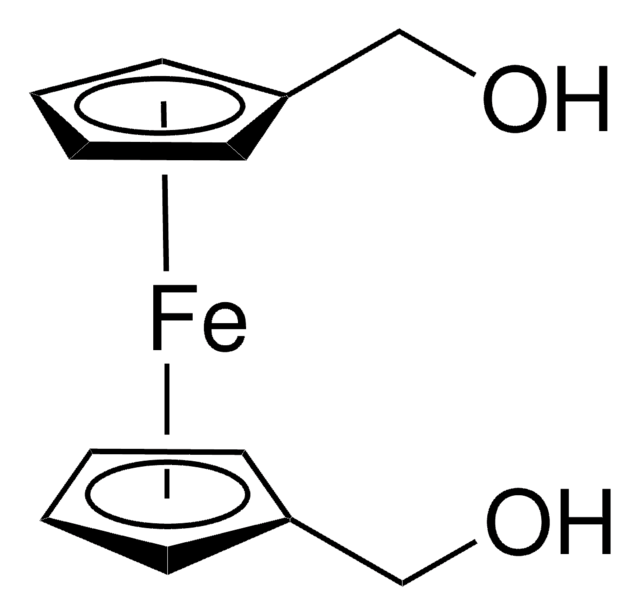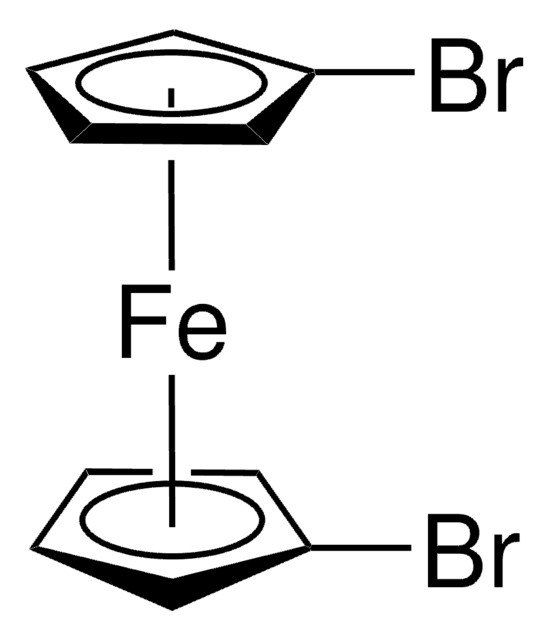109576
1,1′-Dimethylferrocene
95%
Synonym(s):
Bis(methylcyclopentadienyl)iron
Sign Into View Organizational & Contract Pricing
All Photos(1)
About This Item
Empirical Formula (Hill Notation):
C12H14Fe
CAS Number:
Molecular Weight:
214.08
EC Number:
MDL number:
UNSPSC Code:
12161600
PubChem Substance ID:
NACRES:
NA.22
Recommended Products
Quality Level
Assay
95%
form
solid
reaction suitability
core: iron
reagent type: catalyst
mp
37-40 °C (lit.)
SMILES string
[Fe].C[C]1[CH][CH][CH][CH]1.C[C]2[CH][CH][CH][CH]2
InChI
1S/2C6H7.Fe/c2*1-6-4-2-3-5-6;/h2*2-5H,1H3;
InChI key
GJFIEPAJMYPAGC-UHFFFAOYSA-N
Related Categories
Storage Class Code
11 - Combustible Solids
WGK
WGK 3
Flash Point(F)
226.4 °F - closed cup
Flash Point(C)
108.00 °C - closed cup
Personal Protective Equipment
dust mask type N95 (US), Eyeshields, Gloves
Choose from one of the most recent versions:
Certificates of Analysis (COA)
Lot/Batch Number
Don't see the Right Version?
If you require a particular version, you can look up a specific certificate by the Lot or Batch number.
Already Own This Product?
Find documentation for the products that you have recently purchased in the Document Library.
A Alexandre et al.
Biochemical and biophysical research communications, 139(2), 509-514 (1986-09-14)
The synthetic antioxidants butylated hydroxytoluene (BHT), nordihydroguaiaretic acid and the one-electron donor 1,1'-dimethylferrocene, inhibit cytosolic Ca++ increase, shape change, aggregation and ATP secretion in aspirinated washed human platelets stimulated by thrombin, vasopressin and platelet-activating factor. The antioxidants also inhibit cytosolic
P C Pandey et al.
Analytical biochemistry, 260(2), 195-203 (1998-07-11)
Comparative studies of the electrochemical oxidation of reduced nicotinamide coenzyme (NADH) at the surfaces of chemically modified graphite paste electrodes (CMEs) are reported. Three different electroactive materials, tetracyanoquinodimethane (TCNQ), tetrathiafulvalene (TTF), and dimethyl ferrocene (dmFc), were used to construct three
U Bilitewski et al.
Journal of biotechnology, 31(3), 257-266 (1993-12-01)
To achieve effective bioprocess monitoring, sensing systems are required which are suitable for an on-line determination of substrates, inhibitors, nutrients or products. Such devices may utilise biochemical principles, i.e. the specific interaction of biochemical receptors with their surroundings. They can
J C Pickup et al.
Biosensors, 3(6), 335-346 (1987-01-01)
The special requirements for implantable glucose sensors which differ from laboratory analysers and in vitro probes include continuous operation without drift, compatibility with in vivo body conditions, electrical and toxicological safety and patient acceptability. We have studied the effect of
J H Luong et al.
Journal of molecular recognition : JMR, 8(1-2), 132-138 (1995-01-01)
Inclusion complexes of 1,1'-dimethylferrocene (DMFe) with alpha-, 2-hydroxypropyl-beta- or gamma-cyclodextrins were formed in aqueous systems. For the first time, the interacting DMFe-cyclodextrin systems have been characterized using cyclic voltammetry which enabled the estimation of the complexation order, the formation constant
Our team of scientists has experience in all areas of research including Life Science, Material Science, Chemical Synthesis, Chromatography, Analytical and many others.
Contact Technical Service







![N-[3-(Trimethoxysilyl)propyl]ethylenediamine 97%](/deepweb/assets/sigmaaldrich/product/structures/149/508/f87a9a89-f138-4c5e-9fe0-6561914241c3/640/f87a9a89-f138-4c5e-9fe0-6561914241c3.png)
